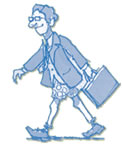 |
| Home | Our Books | Fun Tests | Minding Your Memory | Glossary | Six Functions | Who We Are |
13
Tips for Mega-Memory and Concentration |
Everybody forgets what they went into the A trick to recall what you just forgot The “White Noise” machine Why you can’t remember the first film
of a double-feature Where young brains have an edge Don’t study on an empty stomach Working memory workout Use it or lose it What do “photographic” memory geniuses have going for them? Pills for better memory Visualize it if you want to remember it |
| Building
Mental Muscle Over 230,000 copies sold in the USA alone, plus translations into 14 languages worldwide. |
|

|
Brains
That Work a
Little Bit Differently 2nd best seller. Used in college Psychology courses. ADHD, Left Handedness, Autism, DejaVu, Child Geniuses |
 |
Building
Left-Brain Power It handles the details, like language skills. Every-day tips to use what you learn. Mental exercises that, when done, release serotonin, a feel-good hormone. |
 |
Learn
Faster & Remember More Three guides in one: How skills develop and are maintained through life: 1. Womb to adolescence; 2. Professional Years; 3. Slowing down the slowing down |
 |
Brain
Building Games With Words & Numbers Skill-graded challenges: easy to hard, logic, numbers, crypto-visual plus tricks to maximize performance in every one (176 of them). Another top seller. |
 |
Use
It or Lose It! As the mind matures it begins to lose essential abilities unless.... it is forced to work. Then it builds connections again into old age. |
 |
Exercises
for the Whole Brain A breast-pocket full of visual mental-teasers to work out in spare moments. Now in 13 languages. Especially good for designers and creative thinkers. |
 Right-Brain Teasers Right-Brain TeasersHow many of these photos of 60 old-time, household artifacts can you figure out how they worked and what they were used for? This taps the visual-spatial skills in your right brain. (Men are surprisingly good at this). See an interesting, detailed description when you turn the page after each photo. A fun Valentine gift , especially for elderly antique collectors and flea-market addicts. |
|
^ Back to top of page

